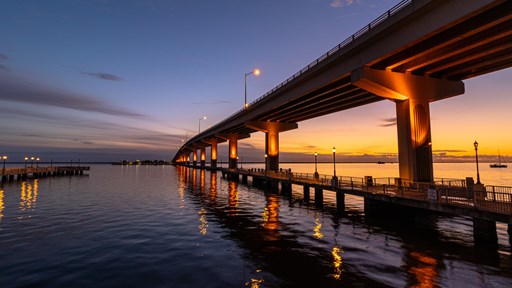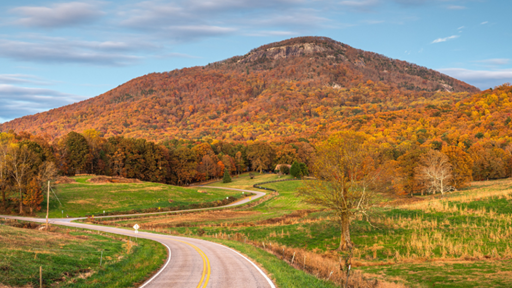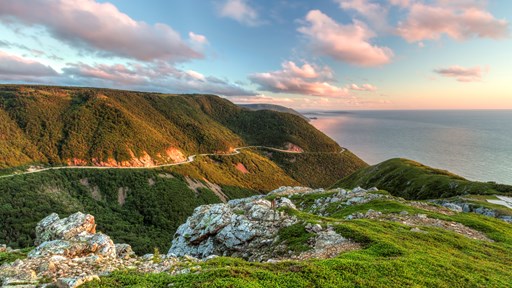With fall just around the corner, now’s prime time to start blocking out your very own “leaf-peeping” safari. Wherever you are in the country, you’re well positioned to enjoy at least some version of fall colors.
Here’s a hop-scotching cruise of some of the most reliable and beautiful fall foliage displays in each general region of the Lower 48. Now, keep in mind this isn’t anywhere close to exhaustive, nor is it intended to constitute an all-out best-in-class roundup. Instead, it’s a spotlight of some (legitimately topnotch) foliage-hunting destinations that show just how awesomely varied leaf-peeping can be.
The Northeast

Eric Kilby
There’s arguably no more celebrated hotspot for fall colors in the world than New England and adjoining eastern Canada. Suffice it to say, autumn in the Northeast may constitute the most iconic seasonal geography on the continent, and you’re simply spoiled for choices when it comes to savoring it.
The White Mountains, New Hampshire
The White Mountains could potentially be the cream of the crop when it comes to leaf-peeping in the U.S. (though be prepared to spark some vigorous debate making that claim). Host to the highest mountains in the Northern Appalachians—the Presidential Range, topping out at 6,288-foot Mount Washington—and a rich checklist of deciduous trees, the Whites see utterly world-class fall colors roll down their slopes from high forests to valley clefts. The Kancamagus Scenic Byway serves as a classic portal for enjoying these superlative seasonal vistas.
The Hudson Valley, New York
From the heights of the bordering Catskills to blufftop forests, New York’s Hudson Valley makes a pilgrimage site for leaf-peepers from around the world. While you’re feasting on views of sugar and red maples, red oaks, birches, and other dazzling canopies, hit up some apple orchards and covered bridges to round out a quintessential immersion in autumnal New England.
The Pocono Mountains, Pennsylvania
The impressive extent of the Poconos and a grab-bag of vibrant-color-turning trees make this reach of the Allegheny Plateau another fall-color epicenter. From Route 507 to the Delaware Water Gap, you’ve got no shortage of options, and the broad latitudinal spread of the Poconos translates to a foliage presentation typically running from mid-September right through mid-October.
The Midwest

gabe popa
The great deciduous diversity, prodigious forestland, and crisp northern-style weather means the Midwest may give New England a run for its money in the fall-colors realm. From the shores of the Great Lakes to rolling morainal countryside, a leaf-peeping safari here hits all the right marks scenery-wise.
The Baraboo Hills, Wisconsin
This ancient uplift rising out of rolling glacial lowlands harbors one of the most significant blocks of forest in farm-quilted southern Wisconsin—and one of the Midwest’s premier leaf-peeping playgrounds. From Devil’s Lake and Mirror Lake state parks to the shady gem of Parfreys Glen, prepare for some kaleidoscopic Badger State canopies.
Sleeping Bear Dunes National Lakeshore, Michigan
Crimson, yellow, orange, and other shades compose a rich fall palette combined with grand sand scarps and the big blue of Lake Michigan at Sleeping Bear Dunes. Good peepin’ spots here include serene North Bar Lake, the far-surveying vantage of Empire Bluff, and historic Point Oneida with its healthy stock of sugar maples.
Pincushion Mountain, Minnesota
The legendary North Shore of Lake Superior in Minnesota paints some of the grandest, most rugged scenery in the Upper Midwest. It looks mighty fine in its late September to mid-October glory, thanks to all the aspens, maples, birches, and poplars gussying up its forests. The vantage of Pincushion Mountain in the Sawtooth Mountains—reachable by the Superior Hiking Trail—takes in a stirring sweep of those fall colors as well as Grand Marais and that greatest of the Great Lakes.
The Southeast

Climatic realities mean the Southeast—despite fostering some of the richest temperate forests in the world—doesn’t attain quite the intensity of fall color as the Northeast or Midwest. But that certainly isn’t to say you can’t revel in extraordinary autumn foliage here, from the high crests of the Blue Ridge to swampside coastal-plain thickets.
Great Smoky Mountains National Park, Tennessee/North Carolina
The Great Smokies are the epitome of the Southern Appalachians when it comes to scenery, wildness, and forest verdure. Given the large gradient of elevation and the whopping number of deciduous tree and shrub types, they also happen to produce one heck of an extended fall-color performance: renowned enough that this most popular American national park usually sees its second-busiest month in October.
Okefenokee Swamp, Georgia/Florida
Really? The Okefenokee Swamp as a place to eyeball some fall-painted leaves? Well, yes. This huge wetland on the Georgia-Florida line features dazzling hues from its abundant red maples, backed up by black-gums and the needle-shedding bald-cypress.
The Southwest

U.S. Forest Service, Southwestern Region, Kaibab National Forest
Another one of those under-appreciated U.S. leaf-peeping destinations, the American Southwest can turn out some smoldering fall color across its incredibly varied landscapes. From the high plateaus of the canyonlands to lofty sky-island mountain ranges in the southern deserts, aspen forests do their stunning stuff, while surprisingly lush riparian strips of maple, cottonwood, sycamore, ash, and other broadleafs light up as well.
Guadalupe Mountains National Park, Texas
The ancient reefs of West Texas’s Guadalupe Mountains rise in otherworldly grandeur out of spare Chihuahuan Desert lowlands. From late October to early November, riparian zones such as McKittrick and Dog canyons put the fiery fall displays of bigtooth maple front and center. Meanwhile, the Guadalupes play host to some of the most southerly stands of quaking aspen in the U.S., contributing a scattered but potent color show to the autumn high country.
Kaibab Plateau, Arizona
Extensive aspen forests on the Kaibab Plateau north of the Grand Canyon give fall visitors to that chasm of chasms an extra incentive to check out its lesser-visited North Rim. Drives and hikes in the Kaibab National Forest’s North Kaibab Ranger District provide plenty of opportunities to experience the trembling yellow canopies firsthand.
Santa Catalina Mountains, Arizona
Southern Arizona’s Coronado National Forest encompasses the majority of the country’s “Madrean sky islands,” high, isolated mountain ranges marooned in the Chihuahuan and Sonoran deserts and supporting an elevational gradient of vegetation zones radically different from those arid lowlands. A wonderful way to experience the colorful foliage that blazes here and there in these sky islands is by taking the Catalina Highway in the Coronado’s Santa Catalinas, which climbs from Sonoran Desert scrub and cactus forest to conifer shade above 9,000 feet on Mount Lemmon. Along the way you can pick out multicolored canyon communities and plenty of aspen groves, not least from the aptly named Aspen Vista Point.
The Pacific Northwest

Alan Cressler
One of the royalest of all conifer kingdoms on the planet, the Pacific Northwest isn’t always on the radar when it comes to fall color—and that’s a shame. True, deciduous trees and shrubs play second fiddle to this wet, rugged land’s evergreen glories, but they step into the spotlight in autumn as the summer dry season leans into the wet, stormy winter—with both western and alpine larches in the Cascades adding to the visual symphony.
Alpine Lakes Wilderness, Washington
Among the Northwest’s most popular backcountries, the Alpine Lakes Wilderness of the Mount Baker-Snoqualmie and Wenatchee national forests is a Cascade Range stunner: jagged, toothy peaks and massifs, loads of postcard-perfect tarns, and—most importantly for the purposes of this here inventory—a magnificent natural garden of alpine larches. There’s no more archetypal look to this mountain kingdom than fall’s arrangement of lit-up larches cast against granitic outcrops and mirrored lakes.
Olympic National Park, Washington
Amid the towering temperate rainforests of the west-side Olympic Mountains, bigleaf maples, vine maples, huckleberries, and other deciduous trees and shrubs ignite the shadowy understory with their piercing fall color. Fine spots to dig the contrast between the vaulting green and bright autumn flare-ups include the Hall of Mosses in the Hoh Rainforest and the Maple Glades in the Quinault Valley.
The Mountain & Intermountain West

Sauntering Photographer
The vastness of this roughly defined, outrageously scenic region encompasses plenty of fall color, though much of it is dominated not by showoff deciduous trees but less-vibrant conifer forests and semi-arid shrublands and grasslands. The all-around star of the fall-color spectacle here is definitely quaking aspen, found scattered in the mountains of the Interior Northwest and the Northern and Middle Rockies but holding court over significant acreage in the Southern Rockies and the Great Basin. That said, another tree—the western larch, one of the world’s relatively few deciduous conifers—puts on a similarly brilliant show in the mountains of eastern Washington, northeastern Oregon, northern Idaho, and northwestern Montana.
Colorado Rockies, Colorado
Aspen crescendos famously in the Southern Rocky Mountains, most of which lie within Colorado. Take your pick: From the Elk Mountains (where the much-photographed Maroon Bells look extra-awesome swelling above golden aspen bands) to the epic San Juans in the southwest, the Colorado Rockies produce some of the best leaf-peeping in the U.S., bar none.
Grand Teton National Park, Wyoming
Aspen’s also well distributed in the Tetons, on the shortlist of the country’s most showstopping mountain ranges. Wandering Grand Teton National Park’s yellow- and orange-crowned “whitewoods” under the gaze of such sublime peaks as Mount Moriah and the Grand Teton itself is dreamy as it comes.
Lolo National Forest, Montana
October sees the larch cathedrals of northwestern Montana crank the ample, all-season scenery of these parts up to high gear. Among the best places anywhere to see the golden splendor these “tamaracks” (as they’re colloquially called) attain this time of year is the Lolo National Forest’s Seeley Lake area, host to some truly titanic larches and such prime vantages as the Double Arrow Lookout.
Camp (or glamp) in comfort on a leaf-peeping odyssey with KOA: You’ll find decked-out Kampgrounds amid eye-popping fall colors in all corners of the country!
Written by Ethan Shaw for Matcha in partnership with Kampgrounds of America.

























